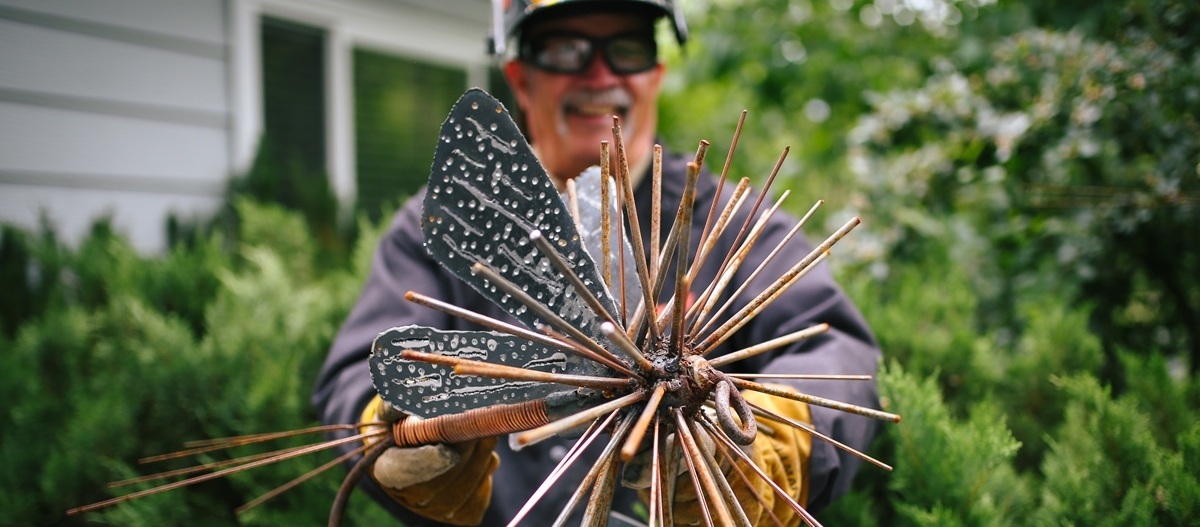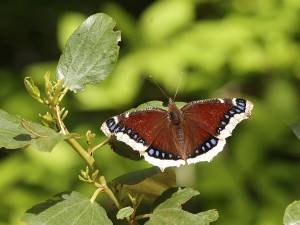It’s about 9:45 on a cool early summer night and sparks—like from a Fourth of July Roman Candle—are jumping from a dimly lit garage off a side street in Helena, Mont.
The lingering dusk doesn’t snuff out these sparks—they just add a kind of excitement to the work going on at this time of night.
Just outside his garage, Mike Gurnett is grinding two pectoral fins, clamped in a small vice, that he will weld onto the body of a shiny nickel-steel trout that he hopes to finish before his fishing trip on the Big Hole River.
The former Montana Fish, Wildlife, and Parks cinematographer didn’t leave behind his creative spirit when he retired at the end of 2014. In fact, he’s busier than ever, serving as chair of the Last Chance Stampede and Fair in Lewis and Clark County, doting on his one-year-old grandson, and turning out the likenesses of trout in raw steel that represent his deep appreciation for the beauty of a state and region that he filmed, photographed, and wrote about for almost four decades as he told the story of a wildly natural place that has no natural voice.
Gurnett, 65, documented Montana’s landscapes, wildlife, and people for 37 years. His documentaries, stories and video newscasts for the Outdoor Report, which played on television stations across the state. They helped Montanans to understand the invaluably rich natural world that lies at our doorstep and the advocates who understand it needs protection for generations to come.
He filmed some of the most iconic places and wildlife in the state, from Yellowstone and Glacier national parks to the Bob Marshall Wilderness Complex and everything in between. He captured powerful images of wildlife and people springing to life, showing Montanans that this so-called Last Best Place is country worth protecting.
But when retirement landed with a thud on his workbench, Gurnett, who grew up in Lewistown and Livingston and searched for something to keep his mind and hands busy.
His wife, Lauri, bought him a welder for Christmas and suggested that he do what he knows best: create things that reflect the natural world.
Raw steel is not the most malleable product. But with an iron will and bull-headed persistence, as well as a refurbished vice, ball-peen hammer, welder, plasma cutter, grinders, and guidance from renowned metal sculptor Jim Dolan of Belgrade, Gurnett waded right in to the turbid waters of the art world.
Gurnett was a former fishing guide whose father was good friends with the fly fishing pioneer Dan Bailey of Livingston. Once retired, Gurnett started to create three-dimensional representations in quarter- to three-eighths-inch thick plates of mild steel that reflect his passion for fish and wildlife and the waters that cleave this state.
“I like to bend metal and shape wood to create an image,” Gurnett says. “With film, you get to make a story. That’s what the [steel] fish are. When someone looks at the fish, hopefully it reminds them of a good moment in their life.”
While filmmaking was intellectually demanding, requiring patience and persistence, Gurnett’s new artistic endeavor requires close study of fish, flies and antlers. It also requires physicality and tactility of constantly lifting steel and beating it with a hammer.
Gurnett uses an air chisel, like a handheld jackhammer, to provide relief to the flat steel that he heats in his new forge—another Christmas present from Lauri.
Pounding on the metal with the hammer helps create the iridescence of, say, a grayling, and makes the steel seem to flex and contort, just as real fish move with the steady movement of small dark clouds in the limpid current of water.
“I love to get them out of the heat and see what color they are,” Gurnett says, noting that the carbon content of the steel helps to dictate colors produced by the heat. “It makes each piece unique.”
He attaches completed works to a steel or walnut base. Some of Gurnett’s salmon weigh up to 32 pounds dry (on a base), and he sometimes airbrushes them with red lacquer, to make them look like they are wet.
“I’m sure Mike’s childhood and career have contributed to his creativity and drive,” his wife says. “But this welder has been another avenue to express his love for the art of the outdoors.”
After a handful of years of building large flies, like mayflies, and fish, Gurnett is studying further with Dolan in Belgrade and Bozeman bronze sculptor Bob Burkhart to “bump it up in complexity” and take on a larger challenge: life-size horses made of steel.
That means starting from the ground up—literally. His first equine project starts with hooves, and will be built up from there. The sculpture will be of his daughter Libby’s red roan quarter horse named Digger, who helped her to win Miss Teen Rodeo Montana in 2010.
“I want to take this to another level,” Gurnett says, adding that the steel horse is intended to stand in a field where Libby and her husband ranch southwest of Dillon.
And standing serenely above outfitter John Maki’s Helena house just below Mount Helena is Gurnett’s newest creation: A fish weathervane. About three-feet long and made of one-eighth-inch flat steel, the vane is what any river guide or rower needs, Gurnett says, because they need to know if the wind will be blowing at their back—a good day—or the wind will be blowing in their face and pushing them back upriver—a bad day.
“Who really needs a weathervane?” Gurnett asks rhetorically. “But it gives you an idea of how good a day you’re going to have.”
Maki asked Gurnett to build him the vane, and, as Gurnett explains, the fish and a hook sit on successive sleeves of pipe and swivel, drifting freely in the slightest breeze thanks to a ball-bearing mount.
As he’s explaining the physics of the aesthetic and practical contraption, Gurnett realizes that the air currents he is talking about affect this lifeless fish just as much as water currents affect real-life trout in a current of water.
“It’s drifting in an air current just like it’s drifting in water current,” Gurnett says. “It’s the same concept.”
From the perch in his garage, Gurnett created Copper Creel, a media and metal art business to market his artwork. Many of his orders come from people walking by who see his art work and ask if he can make them something.
“People have their ideas, and I say, ‘I will give it a shot,’ ” he says.
An outfitter for 44 years, Maki, for instance, always had a weather vane on his ranch. “Rowers always need to know which way the wind blows. It’s usually blowing upstream when you’re trying to get out,” Maki says.
Gurnett, meanwhile, finds his use of time valuable.
He is dedicated to reflecting back the natural world in which he grew up and made his living. His ethic as a volunteer—chair of the Lewis and Clark Last Chance Stampede Rodeo Committee and a board member of the Montana Cowboy Hall of Fame and Western Heritage Center—can “be lumped into an ongoing personal attempt to keep the culture, values, and traditions of the American West relevant to our lives today.”
“You just can’t take some of these things for granted,” Gurnett says of our natural world. MSN









